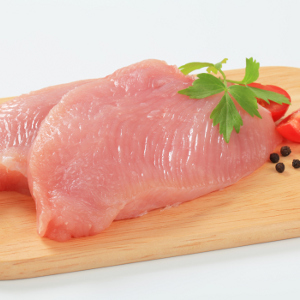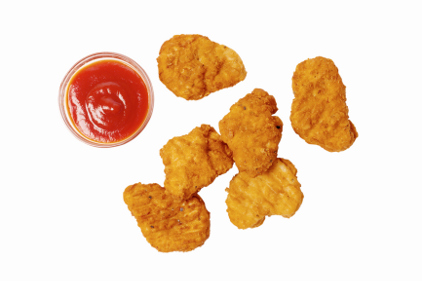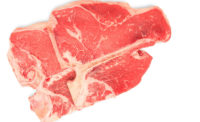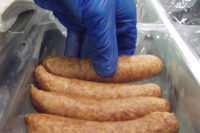 If it isn’t broke, don’t fix it, right?
If it isn’t broke, don’t fix it, right?
Today, most methods of mass cooking and chilling are pretty economical and sufficient for their purpose. However, processors and manufacturers continue to tweak thermal-processing procedures to eliminate remaining challenges.
Automated data-loggers for verifying and validating temperature are seeing widespread adoption, for one.
“Stainless steel, self-contained data-loggers are widely available for all temperature ranges used in our industry, and are more rugged, more reliable and less expensive than ever,” says Bob Hanson, founder of HansonTech, a consulting firm that specializes in thermal processing. “These data-loggers are readily adapted for measuring oven, chiller, freezer and product temperatures for batch and continuous processes, including temperatures up to 500°F.”
New software tools are also emerging that will help determine process lethality.
“I am collaborating with the University of Wisconsin on an AMI Foundation-funded project that has already determined the thermal resistance of three major pathogens on three deli meats,” he says. “The next phase of the project is to conduct further lethality trials using typical meat industry cooking processes, then use all of the data to develop ‘Appendix A’ style time-temperature tables for specific pathogens and products.”
These software tools should be available within the next year.
In advanced thermal processing, new technologies are being developed and tested using enhanced agitation to reduce heating and cooling time, microwave and Ohmic heating to reduce heating time, infrared heating for surface treatment and high pressure assisted thermal sterilization, says Howard Zhang, Ph.D., center director of the USDA Western Regional Research Center, based in Albany, Calif.
“Going one step further, an array of nonthermal-processing technologies are also being developed,” he says. “These technologies preserve food without the use of heat. Examples include high-pressure processing, pulsed electric fields, irradiation, UV light, ozone, chlorine dioxide gas, plasma and ultrasound.”
Although high-pressure processing and irradiation are applied in limited scope, other nonthermal technologies are yet to find commercial applications in the food industry, he notes.
Adding new controls
The chilling process, whether it’s air blast, immersion, spray, crust, rapid or cooking under vacuum, is still mostly labor-dependent and therefore full of variability.
The biggest challenge, however, for most meat processors is that many meat products are still being chilled in legacy air coolers with uneven rates of cooling.
|
Air chilling challenges, benefits What’s old is new again, or is it? Air chilling poultry has been common in Europe and Canada for about 45 years, but hasn’t taken off in the United States just yet. However, it’s getting another look as processors comply with European Union trade restrictions, USDA regulations and environmental protections. In the United States, poultry carcasses must be cooled to 40°F or less within four to eight hours after slaughter to prevent pathogen and spoilage microorganism growth. Processors can cool poultry carcasses with three methods: immersion chilling with cold water or an ice-water combination, dry air chilling with cold-air blasts or evaporative air chilling with cold air blasts and water mist. According to Ashley Peterson, Ph.D., National Chicken Council (NCC), vice president of science and technology, based in Washington, D.C., the NCC estimates that “less than three percent of total broiler production relies solely on air chilling as customer demand is simply not as high for the product.” She notes that air chilling may not be the primary method used by the poultry industry because of the longer time required to chill carcasses, the need for increased room to chill (chilling tracks can be three to six miles long) and the potential to dry out the surface of the carcass. It also requires time and money to set up the new system and educate consumers on why the product may taste differently than what they are used to and why air chilling is a viable chilling method. “Immersion chilling is a more efficient process and eliminates the possibility of drying out the carcass,” she says. “There is some unavoidable moisture picked up on the carcass using the immersion process, which is why it is declared on the label.” Bell & Evans, based in Fredericksburg, Pa., opened its air-chilling plant in 2005, after its owner Scott Sechler traveled the world looking for the best way to chill poultry. “We want to be the best in the world, so we offer single-level line chilling in three different chambers, on six miles of track, which winds up taking two hours and 45 minutes to chill product,” says Tom Stone, director of marketing for Bell & Evans. Air chilling is requested by customers who are willing to pay more for this particular product. “The average consumer would be shocked and disappointed to learn how much they are paying for water [in the bird] otherwise,” notes Stone. Air chilling also offers different potential export opportunities to countries that may prefer importing some poultry products produced with this method, says Peterson. There are always concerns about the amount of water it takes to process poultry and other types of livestock, which with water chilling could run up to 400,000 gallons a day. Although air chillers save on water usage, they rack up higher electrical costs. “Plants are always focused on identifying new opportunities to reduce water consumption, improve efficiency and many plants have wastewater treatment facilities on-site,” says Peterson. For example, Bell & Evans does its own water treatment at its facility, puts clean water (but not potable) back into streams, and reuses some water for washing trailers, notes Stone. |
“Identifying and monitoring the slowest cooling area is difficult due to the large size, slow-moving air, uneven airflow and intermittent loading of hot product into these coolers,” says Hanson.
Processors are adopting dedicated blast chillers to overcome this problem. These blast chillers are most often sized to hold one oven-load of product, and thus assure fast and uniform cooling, he says.
Another challenge is when product becomes chilled too quickly; thereby leaving trapped hot spots that can allow bacteria to grow, says Jeff Sindelar, assistant professor/extension meat specialist at the Meat Science & Muscle Biology Laboratory at the University of Wisconsin-Madison.
“If the crust freezes too severely, the trapped heat can create hot spots, and then you have a thermal barrier,” he says. “The goal instead is to take the product out of the temperature zone where bacteria can grow.”
It can still be challenging for processors to cool product in an efficient manner that also maintains a desirable rate of cooling.
“The cooling process contains a lot of variability, so processors need to understand the basic elements of how large their product is, how long it takes to remove heat from it, the impact of their equipment on the rate of cooling and how these relationships need to be maximized to create the most efficient cooling process,” says Sindelar.
Training and documentation are crucial, in fact, because the front-line production workers and quality-assurance techs are responsible for monitoring this inexact process.
Some questions to consider, says Hanson, are did the workers position the probes in the slowest heating (or cooling) spot in the product? Did they actually measure the temperatures, or just fill in the blanks? Are workers trained on the expected cold and hot zones? When there is a process deviation, do the workers know how to respond?
“Also, it makes sense for the industry to move to manufacturing systems that are process-dependent, and not people-dependent, such as in-package pasteurization and high-pressure pasteurization,” says Hanson.
The potential for cross-contamination in brine chillers is still a problem, he notes, although citric- and acetic-acid treatments have been effective in controlling pathogens in chiller brines.
Reduce, reuse, recycle energy
A large meat-processing facility can go through 2 million gallons of water every day. But how many natural resources (and how much money) would be saved if plants could use and reuse that freshwater source up to three times — first for food safety, then for inedible uses and finally for local irrigation once it’s treated.
Turns out, quite a bit, as meat and poultry processors are finding it worth their while to experiment with energy conservation and water-reduction technologies during the cooking, chilling and freezing processes.
“Specifically related to water, many companies treat water by using current technologies such as reverse osmosis, ozone and UV light treatment,” says Ashley Peterson, Ph.D., National Chicken Council, vice president of science and technology, based in Washington, D.C. “This allows companies to reuse this water in other locations in the plant. Many companies have also installed specialized nozzles, water meters and cut-off valves, just to name a few.”
Energy-reduction initiatives involving cooking and cooling can be focused on simple, effective methods as well, such as running fans on low speeds when possible, reducing pre-heat times, insulating hot and cold piping and using lower dry-bulb temperatures when possible, says Hanson.
“For energy, conservation results in cost savings — and many of those cost savings pay off year after year,” he explains. “Processes can be optimized to increase yields and shorten cooking times — both resulting in increased plant efficiency and reduced energy costs.”
Enlisting employee help
A meat facility is like a giant icebox after all. Where the animals enter the plant, it’s warm. But once the animals are harvested, half carcasses can be stored in a chiller for up to 48 hours before they are graded.
Cargill’s Fort Morgan, Colo.-based plant, for example, can have up to 30,000 carcass halves at any given time, and they all need to stay cold to remain fresh and inhibit any kind of bacteria growth.
“In western Kansas or the panhandle of Texas, it gets very hot, and the plant needs to keep an internal temperature of 35 to 40 degrees,” says Scott Hartter, vice president of environment, health and safety for Cargill Meat Solutions, based in Wichita, Kan. “That requires a lot of energy, so if we’re not efficient, we incur lot of costs.”
Since 2001, Cargill has created and committed to a formalized plan to aggressively reduce its environmental impact (with five-year goals) and become an ISO 14001-certified program.
Consequently, the company has produced its meat with 10.5 percent less energy, reduced water usage by almost 15 percent, experimented with renewable energy such as biogas recovery at 11 of its North American facilities, and captured and reduced methane and carbon dioxide gases by 20 percent, which recovers fuel and odors to the community.
To accomplish its conservation goals, Hartter says Cargill educates and involves its employees, puts the right processes in place and invests in capital improvements with newer refrigeration, lighting and heating systems.
“The most important aspect within a formalized program is employee involvement,” he says. “Our energy teams meet weekly. We offer recognition and awards for employee energy-saving ideas, and [we] provide a lot of training. Folks like to be part of solutions and see ideas put in place and acted upon by their company.”
Reviewing best practices
Hormel Foods is also continuously looking for opportunities to improve conservation processes through new technology and management practices. The company considers all energy and water usage in regard to every new product and process development, and reviews existing processes and products as well.
“We met our goal to reduce water consumption by 10 percent by the end of fiscal year 2011, one year early in 2010; however, we continue to focus on water-reduction projects at our facilities and have set a new water goal beginning in fiscal year 2012,” says Chad B. Sayles, manager of mechanical and electrical engineering for the corporate engineering division at Hormel Foods, based in Austin, Minn.
In 2011, Hormel’s initiatives resulted in an additional decrease in water consumption. Total water use during 2011 was 4.9 billion gallons — an absolute reduction of 4 percent, or 210 million gallons from the previous year. Since 2006, total water reduction was 15 percent when normalized for production — an absolute reduction of 670 million gallons.
“Water systems are used in many aspects of production, and each system is unique and must be analyzed to determine the best use,” says Sayles. “In general, we attempt to capture water used for cooling, remove the heat and use the heat for the benefit of another process. If possible, we reuse the water in the cooling process or in some other useful way.”
In 2006, Hormel Foods set a goal to reduce energy consumption at its U.S. manufacturing facilities by 10 percent per thousand pounds of production by the end of fiscal year 2011, using fiscal year 2006 as the baseline year.
“At the end of 2011, we held the growth of normalized energy consumption to less than 1 percent of the fiscal year 2006 benchmark level,” says Sayles. “By the end of fiscal year 2011, direct energy consumption decreased 1 percent compared to 2006 levels when normalized for production, and indirect energy consumption increased approximately 1 percent.”
Moreover, Hormel Foods has an annual Environmental Sustainability Best of the Best competition that rewards employees for their work in the area of sustainable projects.
“Hormel Foods continues to pursue opportunities to save energy and water,” says Sayles. “As technology and process change over time, new opportunities for additional savings become available.”






Report Abusive Comment